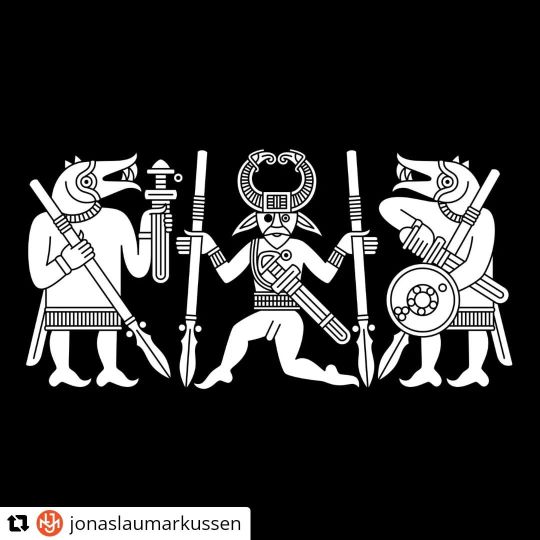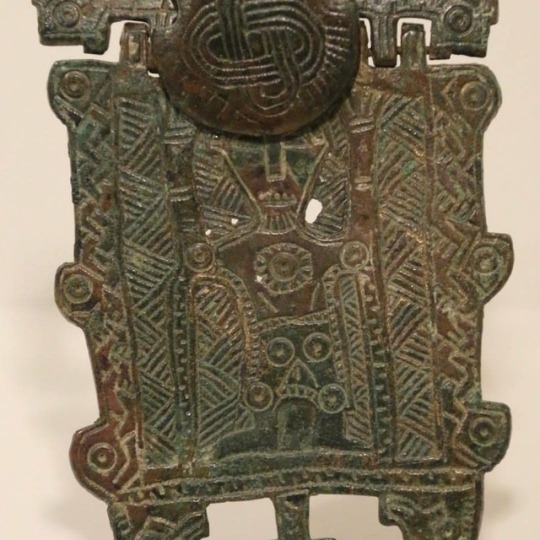#germanicart
Photo

Repost @jonaslaumarkussen with @let.repost • • • • • • Helmet Plate Oðinn Figure Flanked by Beast-headed Warriors The illustration displays some typical characteristics of the motifs on the helmet plates. The motif shows an Oðinn figure flanked by two armed figures with animal heads. Beast-headed Warriors It is unclear if the figures on each side are wearing animal heads or if they are humanoid figures with animal heads. Nor is it clear, due to the stylistic rendition of the animal heads, precisely what kind of animals they are, though they are clearly predatory mammals with sharp teeth like bears or wolves and not boars or birds. The beast-headed figures are armed, and one is holding a sheathed sword up in front of him as to give it to the Oðinn figure facing him. Their half man, half beast appearance and close connection to the Oðinn figure indicate that they are probably directly linked to berserkir. Berserkir were known for their berserkergang ('going berserk') when they went into battle. Going berserk meant doing some kind of shape-shifting in which the berserkr gained superhuman animalistic powers and characteristics. Oðinn Figures The most iconic feature of an Oðinn figure is their headdress composed of two inwards-curling horns with bird-head terminals (clearly birds of prey), a large rectangular forehead piece and triangular animal-ear-like shapes protruding on each side of the head below the headdress. The Oðinn figures usually carry downwards-facing spears, either two in one hand and a sword in the other or one spear in each hand. Though they occur dressed in caftans, they often appear naked, only wearing a belt and a sheathed sword in a baldric looping around their shoulder, sometimes even with exposed genitals. Their stance seems to be dancing or jumping, indicating motion. The images on the helmet plates are all scenes pertaining to Oðinn's domain of war, elite warriors, fate, magic and shape-shifting. Oðinn, as a central figure in mythology connected to magic, warfare and rulership, began to take shape during the mid-sixth century developing through the Viking age. #StyleIIB #GermanicArt #HelmetPlates #GermanicIronAge #ShapeShifter https://www.instagram.com/p/Ci0t3X5L-pT/?igshid=NGJjMDIxMWI=
15 notes
·
View notes
Photo

Solar Cross Design II #germanic #germanicpagan #germanic paganism #germanicart #norse #norsepagan #norsepaganism #norseart #solar #solarcross #cross #drawing #pencildrawing https://www.instagram.com/p/B1qmoWZHlXC/?igshid=1gnxespmof0q8
#germanic#germanicpagan#germanicart#norse#norsepagan#norsepaganism#norseart#solar#solarcross#cross#drawing#pencildrawing
0 notes
Photo

Fuck yeah #krampus #apparel at #celtichammerclub Original Krampus #artwork on quality #tees and #hoodies It's not #christmas yet, but watch yourself because Krampus is always watching! #krampusnacht #krampusnight #merrykrampus #gussvomkrampus #grußvomkrampus #celtic #krampusclothing #krampustee #krampushoodie #christmasdemon #germanic #folklore #legend #folk #folklegend #celticart #germanicart #neoceltic @keystone_krampus_
#celtichammerclub#artwork#christmas#germanic#krampusclothing#folk#apparel#krampusnacht#folklore#celticart#gussvomkrampus#celtic#krampusnight#krampushoodie#krampustee#merrykrampus#hoodies#germanicart#legend#neoceltic#tees#folklegend#krampus#christmasdemon#grußvomkrampus
0 notes
Photo

#Repost @jonaslaumarkussen with @let.repost • • • • • • Helmet Plate Battle Scene The illustration displays some typical characteristics of the motifs on the helmet plates. The central figure of this type of motif is a mounted warrior with a helmet, shield, and sword lifting a spear horizontally across the top of the composition. A tiny Oðinn figure behind him above the horse seems to guide the spear, holding on to it with his hand. One or two other warriors in front of and below the horse appear to attack or try to grab hold of the horse. Often a warrior is seen stabbing the horse with his sword from below. The image is thus divided diagonally into two halves, one depicting forces aiding the rider into the battle and the other half forces opposing him. The overarching theme might be fate. The underlying composition might derive from Roman funeral art, with the 'fallen warrior' motif frequently depicting warriors trampling vanquished enemies. Though, the motif on the helmet plates is heavily adapted in line with Scandinavian tradition. The helmet plate designs are contemporary with Style II B (c. 550–650) and display many of the same style characteristics. #StyleIIB #GermanicArt #HelmetPlates #GermanicIronAge https://www.instagram.com/p/Cn4WP4DteWd/?igshid=NGJjMDIxMWI=
0 notes
Photo

Detail from an impressed leather Anglo-Saxon Seax sheath from Christchurch place in Ireland (photos by Matt Bunker). It is dated to the mid 11th century and displays Germanic interlace patterns of a type typical in continental Saxon art. We see interlace patterns of various styles from the migration era to the viking era on brooches, swords runestones etc - things that last. More rarely we find wooden examples such as church doors and viking ships engraved with intricate knotwork. But never assume that more perishable materials like leather were not equally adorned with these beautiful intricate patterns! Imagine a Germanic world filled with patterns and colours. Wherever they could, these people embellished their possessions with colours, previous metals and complicated interwoven knot like serpentine patterns. I wish this was reflected in dramatic representations and historical reconstructions of these peoples' clothing! #Germanicart #anglosaxonart #seax #leatherwork #medievalart #irishhistory #anglosaxonhistory https://www.instagram.com/p/CEOdsOjAa7F/?igshid=vsm4ocxq8syq
14 notes
·
View notes
Photo

My next video will be about the pan-Germanic bird-horned weapon dancer motif found mainly in Anglo-Saxon and Norse artwork. The motif is found in various archaeological contexts, all of which will be covered, and is usually agreed to depict a dancing ritual as part of the cult of Odin/Woden. These two pictures were created for the video by the artist @hungerstein_sketchbook his art also features on a t-shirt available in my Teespring store now (link in bio) #HornedMan #Odin #Woden #Weapondancer #VendelEra #AngloSaxon #GermanicArt #Vikings #Nordic #NorseMythology #VeryIndoEuropean #Warrior #Paganism https://www.instagram.com/p/B_cmQ5bATmZ/?igshid=3ye3zahzm3g0
#hornedman#odin#woden#weapondancer#vendelera#anglosaxon#germanicart#vikings#nordic#norsemythology#veryindoeuropean#warrior#paganism
7 notes
·
View notes
Photo

Germanic raptor brooches are found across the Germanic world from the Merovingian to the Viking era. These first two date to 500ad and are Alemannic or Frankish, the other two are from Germany in the Migration era. Both are made with gold and garnets which are cut to fit into gold cells. Its a beautiful technique called cloisonné #cloisonne #migrationera #frankish #germanicart #germanicartifacts #germanic #darkages #barbarians (at The Metropolitan Museum of Art, New York) https://www.instagram.com/p/Bx0D4GVAOxc/?igshid=19558ccc4m1gv
23 notes
·
View notes
Photo

Examples of Germanic brooches/buckles from Switzerland. Dating to the migration era/vendel era #migrationera #germanicart #folkvandringstid #vendelera #norseart #swisshistory #geneva (at Musées d'art et d'histoire de Genève) https://www.instagram.com/p/BpNcoDEFsDo/?utm_source=ig_tumblr_share&igshid=186vrx8c6kuto
25 notes
·
View notes